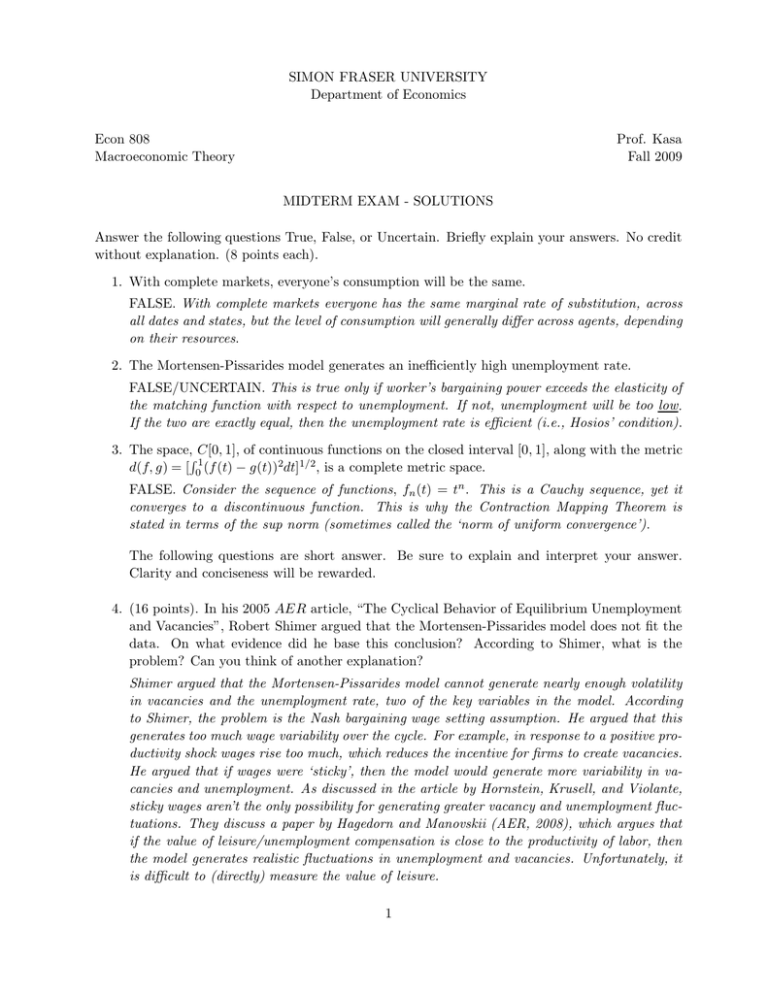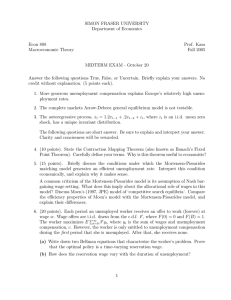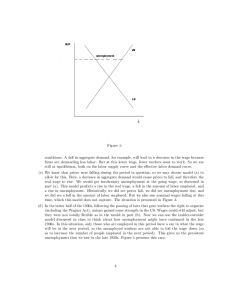SIMON FRASER UNIVERSITY Department of Economics Econ 808 Prof. Kasa
advertisement

SIMON FRASER UNIVERSITY
Department of Economics
Econ 808
Macroeconomic Theory
Prof. Kasa
Fall 2009
MIDTERM EXAM - SOLUTIONS
Answer the following questions True, False, or Uncertain. Briefly explain your answers. No credit
without explanation. (8 points each).
1. With complete markets, everyone’s consumption will be the same.
FALSE. With complete markets everyone has the same marginal rate of substitution, across
all dates and states, but the level of consumption will generally differ across agents, depending
on their resources.
2. The Mortensen-Pissarides model generates an inefficiently high unemployment rate.
FALSE/UNCERTAIN. This is true only if worker’s bargaining power exceeds the elasticity of
the matching function with respect to unemployment. If not, unemployment will be too low.
If the two are exactly equal, then the unemployment rate is efficient (i.e., Hosios’ condition).
3. The space, C[0, 1], of continuous functions on the closed interval [0, 1], along with the metric
R
d(f, g) = [ 01(f (t) − g(t))2dt]1/2, is a complete metric space.
FALSE. Consider the sequence of functions, fn (t) = tn . This is a Cauchy sequence, yet it
converges to a discontinuous function. This is why the Contraction Mapping Theorem is
stated in terms of the sup norm (sometimes called the ‘norm of uniform convergence’).
The following questions are short answer. Be sure to explain and interpret your answer.
Clarity and conciseness will be rewarded.
4. (16 points). In his 2005 AER article, “The Cyclical Behavior of Equilibrium Unemployment
and Vacancies”, Robert Shimer argued that the Mortensen-Pissarides model does not fit the
data. On what evidence did he base this conclusion? According to Shimer, what is the
problem? Can you think of another explanation?
Shimer argued that the Mortensen-Pissarides model cannot generate nearly enough volatility
in vacancies and the unemployment rate, two of the key variables in the model. According
to Shimer, the problem is the Nash bargaining wage setting assumption. He argued that this
generates too much wage variability over the cycle. For example, in response to a positive productivity shock wages rise too much, which reduces the incentive for firms to create vacancies.
He argued that if wages were ‘sticky’, then the model would generate more variability in vacancies and unemployment. As discussed in the article by Hornstein, Krusell, and Violante,
sticky wages aren’t the only possibility for generating greater vacancy and unemployment fluctuations. They discuss a paper by Hagedorn and Manovskii (AER, 2008), which argues that
if the value of leisure/unemployment compensation is close to the productivity of labor, then
the model generates realistic fluctuations in unemployment and vacancies. Unfortunately, it
is difficult to (directly) measure the value of leisure.
1
5. (30 points). Assume the economy is either in a boom (B) or recession (R), each with probability 1/2. The state of the economy (R or B) is i.i.d. over time. At the beginning of each
period, workers know the state of the economy for that period, and they can either choose
to work at their previous wage or draw a new wage. If a new wage is drawn the old wage is
lost, b is received this period, and then work begins at the new wage next period.
During recessions, new wages (for jobs that begin next period) are i.i.d. draws from the c.d.f.
F , where F (0) = 0 and F (M ) = 1 for M < ∞. During booms, the worker can choose to quit
and take two i.i.d. draws from F of a possible new wage, with the option of working at the
higher wage (again for a job starting next period). Getting multiple offers during booms is
one way to formalize what “booms” mean to workers. Workers who are unemployed at the
beginning of a period receive b this period, and then either draw one (in recessions) or two
(in booms) wage offers next period.
P
t t
All workers seek to maximize E0 ∞
t=0 (1 − α) β yt , where α < 1 is the probability that a
worker dies at the end of a period, and yt is the worker’s income in period-t (i.e., yt = wt
when employed, and yt = b when unemployed.
(a) Write down two Bellman equations that characterize the optimization problem of employed workers.
The value function in recessions is
(
X
X
1
1
V (w, R) = max
w + β(1 − α)
V (w, s0), b + β(1 − α)
2
2
stay,quit
s0
s0
Z
M
0
0
0
0
0
V (w , s )dF (w )
)
0
and the value function in booms is
(
X
X
1
1
V (w, B) = max
w + β(1 − α)
V (w, s0), b + β(1 − α)
2
2
stay,quit
s0
s0
Z
M
2
Z
M
V (w0, s0)dGs (w0)
0
where GR (w) = F (w) and GB (w) = F 2 (w). Since F 2 (w) ≤ F (w) we know
X
X
1
1
wR + β(1 − α)
V (wR, s0) ≤ wB + β(1 − α)
V (wB , s0)
2
2
0
0
s
s
Finally, since V (w, s) is (weakly) increasing in w, we have wB ≥ wR . Hence, workers
may accept a job during a recession, then quit during a boom. Intuitively, the value of
quitting increases during booms since job offers are better.
2
)
V (w , s )d(F )(w )
0
(b) Characterize a worker’s quitting policy. Will an employed worker ever quit? If so, who
quits and when? Explain. (Hint: Note that the event max{w1, w2} < w is the event
(w1 < w) ∩ (w2 < w). Therefore, prob(max{w1, w2} < w) = F (w)2 , and F (w)2 ≤ F (w),
i.e., F 2 first-order stochastically dominates F ).
The right-hand side of each Bellman equation is independent of w, while the left-hand
side is increasing in w. Hence, the optimal policy is a pair of reservation wages, wR and
wB . They are characterized by the indifference conditions
X
X
1
1
ws + β(1 − α)
V (ws , s0) = b + β(1 − α)
2
2
s0
s0
0
6. (30 points). Consider an economy where workers are not allowed to quit their jobs. At the
same time, jobs are exogenously destroyed each period with probability α. If a worker’s job is
destroyed, she draws a new wage, and can immediately start working at the new wage. If she
rejects the wage offer, she will have to wait until the beginning of next period to draw a new
wage. In other words, workers without a job receive one wage offer per period, and can start
working in the same period the wage offer is received (i.e., all accepted jobs last for at least
one period). New wages are i.i.d. draws from the c.d.f. F , where F (0) = 0 and F (M ) = 1
for M < ∞.
While unemployed, a worker receives unemployment benefits of b. Workers seek to maximize
P
t
E0 ∞
t=0 β yt , where yt is the worker’s income in period-t (i.e., yt = wt when employed, and
yt = b when unemployed.
(a) Write down the Bellman equation for an unemployed worker. Characterize the reservation
wage. (Discuss the special case when α = 1).
Let V u (w) be the value function for an unemployed worker with wage offer w. Let
V e (w) be the value function for an employed worker with wage, w, at the beginning of
the period (i.e., before learning whether her job is destroyed). These value functions are
characterized by the following Bellman equations
V u (w) =
max
accept,reject
{w + βV e (w), b + βQ}
V e (w) = αQ + (1 − α)(w + βV e (w))
where
Q=
Z
M
(1)
(2)
V u (w0)dF (w0)
0
Equation (2) can be solved for V e (w) as follows
V e (w) =
(1 − α)w + αQ
1 − β(1 − α)
(3)
As expected, V e (w) is increasing in w. Substituting this into equation (1) reveals that
the worker’s optimal policy is a reservation wage, wu . Using eq. (3), we get
wu = (1 − β)(b + βQ) + βα(b + βQ − Q)
(4)
Notice that when α = 1 we get wu = b, which makes sense, since if α = 1, a job lasts
only one period, so only current payoffs matter.
(b) Compute the economy’s stationary aggregate unemployment rate. (Again, discuss the
special case when α = 1).
Let Ut be the unemployment rate at the beginning of the period. Each period a fraction,
1 − F (wu ), of unemployed workers accept a job offer. At the same time, a fraction, α,
of employed workers are fired and draw a new wage. Of these, a fraction F (wu ), reject
their offer. Thus, we have the following law of motion for Ut ,
Ut+1 = Ut + α(1 − Ut )F (wu ) − Ut(1 − F (wu ))
= α(1 − Ut )F (wu ) + Ut F (we )
3
Setting Ut+1 = Ut = Ū gives the following expression for the steady state unemployment
rate
Ū =
αF (wu )
1 − (1 − α)F (wu )
Not surprisingly, when α = 1 we just get Ū = F (wu ).
(c) Now suppose there are two types of jobs: short-lasting jobs with destruction probability
αs , and long-lasting jobs with destruction probability α` , where αs > α` . When a worker
draws a new wage from F , the job is now randomly designated as either short-lasting
(with probability πs ) or long-lasting (with probability π` ), where πs +π` = 1. Assume the
worker observes the characteristics of a job offer, (w, α). Does an unemployed worker’s
reservation wage depend on whether a job is short-lasting or long-lasting? Explain.
Now α becomes a state variable. The two Bellman equations become
V u (w, α) =
max
accept,reject
{w + βV e (w, α), b + βQ}
V e (w, α) = αQ + (1 − α)(w + βV e (w, α))
where now
Q = πs
Z
M
V u (w0, αs )dF (w0) + π`
Z
0
M
(5)
(6)
V u (w0 , α`)dF (w0)
0
Clearly, there will now be a pair of reservation wages, for each of the two different job
types, αi , i = s, `. Applying the same solution strategy as in part (a) gives us the following
expression for the reservation wages
wu (αi ) = (1 − β)(b + βQ) + βαi (b + βQ − Q)
(7)
Notice that b + βQ ≤ Q. (Since Q is the value of being unemployed before drawing
a wage, it must be at least a good as rejecting the wage forever and simply consuming
the unemployment benefit, i.e., Q ≥ b/(1 − β)). From eq. (7), we then see that wu (α)
is a (weakly) decreasing function of α. Therefore, wu (α` ) ≥ wu (ws ). The intuition is
clear - since by assumption you can’t quit, you will be especially choosey when taking a
long-lasting job.
(d) Finally, now suppose workers can quit their jobs. Specifically, at the beginning of each
period (before knowing whether her job will be destroyed) an employed worker can
quit her job, draw a new wage offer, and immediately start work at the new wage.
Characterize the worker’s optimal policy. How does your answer to part c change?
When quitting is allowed, an employed worker has a nontrivial Bellman equation. We
have,
V u (w, α) =
V e (w, α) =
{w + βV e (w, α), b + βQ}
(8)
max {αQ + (1 − α)(w + βV e (w, α)), Q}
(9)
max
accept,reject
stay ,quit
where again
Q = πs
Z
M
V u (w0, αs )dF (w0) + π`
0
Z
M
0
4
V u (w0 , α`)dF (w0)
The reservation wage, we (α), for an employed worker satisfies the usual indifference
condition:
αQ + (1 − α)(we (α) + βV e (we (α), α)) = Q
Since by definition V e (we (α)) = Q, we then get
we (α) = (1 − β)Q
⇒
we (α)
=Q
1−β
Thus, the reservation wage for an employed worker is independent of job type. At the
reservation wage, an employed worker is indifferent between staying, quitting, and being
fired (because she can immediately draw a new wage). Thus, at the reservation wage, the
value of staying forever at the current job is equal to the value of quitting.
To calculate wu (α), first note that, as before, b + βQ ≤ Q. Thus, the right-side of the
max operator in (8) is smaller than the right-side of the max operator in (9). Since at
the reservation wage the left-sides of the max operators are the same, we know
wu (α) ≤ we (α)
Therefore, V e (wu (α)) = Q (since V e (w) = Q when w ≤ we ). Using this in the indifference condition in (8) implies
wu (α) = b
Clearly, when a worker has the option to quit and immediately take a new wage draw
without enduring any unemployment, it will be optimal to accept any wage above b.
(Remember, in the standard McCall model, it was assumed that if the worker quit, he
had to spend one period unemployed before he could draw again).
5




